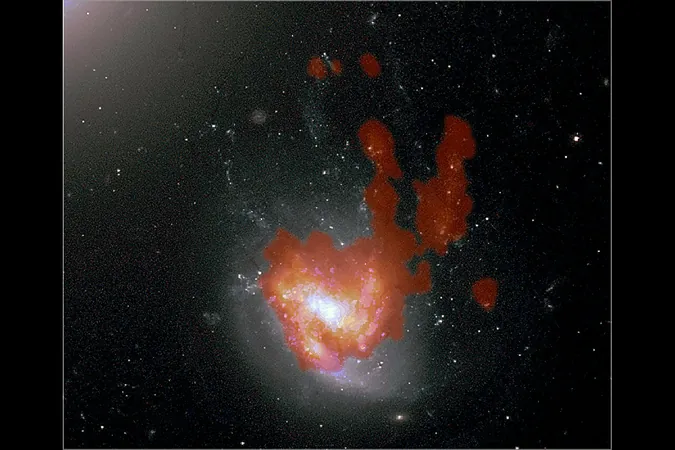
Unlocking the Secrets of a 'Jellyfish' Galaxy with Fascinating 'Bunny Ears'!
2025-06-12
Author: Siti
Prepare to be amazed! Astronomers have unveiled stunning new insights into an extraordinary galaxy dubbed the "jellyfish" galaxy, known scientifically as NGC 4858. This cosmic wonder, located over 300 million light-years away in the Coma cluster, boasts a striking shape and internal features that resemble cute "bunny ears" and an inner "tail"!
Led by Yale's brilliant minds, Harrison Souchereau and Jeffrey Kenney, this groundbreaking study illuminates the dynamic forces at play in this extreme galactic environment. Galaxy clusters like the Coma are colossal structures housing an array of hot gas, dark matter, and a multitude of galaxies, sometimes numbering in the thousands!
As NGC 4858 zips through this intricate cosmic landscape, it experiences a harsh phenomenon known as ram pressure. This relentless cosmic "wind" strips away the galaxy's internal gas, giving it an elongated, jelly-like appearance complete with trails that mimic jellyfish tentacles!
"Imagine this galaxy racing through a wind tunnel at breakneck speeds! It’s losing its gas due to the powerful winds," explains Souchereau, a doctoral student at Yale. With high-resolution imaging from the ALMA radio telescope, researchers captured the breathtaking details of NGC 4858's jellyfish structure and uncovered even more surprises!
One of the most captivating discoveries? The ram pressure has created distortions that look just like bunny ears on the galaxy’s spiral arms! The combined effect of environmental forces and the galaxy's rotation is responsible for this whimsical cosmic feature.
Moreover, the study revealed a phenomenon known as "fallback," where gas ejected from the galaxy disk has the potential to return. While fallback isn’t new, it hasn't been captured with such clarity before. "This galactic fountain creates concentrated gas in the distorted spiral arms, giving them a unique shape!" Souchereau notes.
The team shared these breathtaking findings at the American Astronomical Society's summer meeting, and the full study is available for eager minds to explore on the arXiv preprint server.
With contributions from an international collaborative team, including researchers from countries across the globe, this study not only enriches our understanding of cosmic structures but also showcases the beauty and diversity of our universe. Could this jellyfish galaxy lead to new revelations about star formation? Stay tuned for more exciting discoveries!


 Brasil (PT)
Brasil (PT)
 Canada (EN)
Canada (EN)
 Chile (ES)
Chile (ES)
 Česko (CS)
Česko (CS)
 대한민국 (KO)
대한민국 (KO)
 España (ES)
España (ES)
 France (FR)
France (FR)
 Hong Kong (EN)
Hong Kong (EN)
 Italia (IT)
Italia (IT)
 日本 (JA)
日本 (JA)
 Magyarország (HU)
Magyarország (HU)
 Norge (NO)
Norge (NO)
 Polska (PL)
Polska (PL)
 Schweiz (DE)
Schweiz (DE)
 Singapore (EN)
Singapore (EN)
 Sverige (SV)
Sverige (SV)
 Suomi (FI)
Suomi (FI)
 Türkiye (TR)
Türkiye (TR)
 الإمارات العربية المتحدة (AR)
الإمارات العربية المتحدة (AR)